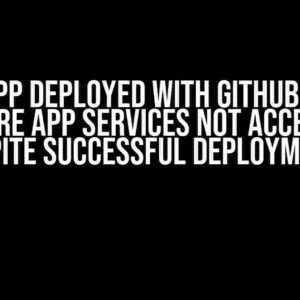As a developer, you know how crucial it is to manage access to your packages efficiently. With GitHub Packages, you can do just that! But, what if you want to take it to the next level and manage access to your packages from Actions using API? Well, you’re in the right place! In this article, we’ll dive into the world of GitHub Packages and explore how to manage access to your packages from Actions using API.
What are GitHub Packages?
Before we dive into the nitty-gritty, let’s start with the basics. GitHub Packages is a package management service that allows you to host, manage, and share packages with your team and the open-source community. With GitHub Packages, you can store and manage different types of packages, including npm, RubyGems, Maven, and more.
Benefits of Using GitHub Packages
- Secure and Reliable: GitHub Packages provides a secure and reliable way to store and manage your packages. You can rest assured that your packages are safe and easily accessible.
- Faster Deployment: With GitHub Packages, you can deploy your packages faster than ever before. No more waiting for hours or even days for your package to be available.
- Improved Collaboration: GitHub Packages makes it easy to collaborate with your team and the open-source community. You can easily share and manage access to your packages with others.
- Version Control: GitHub Packages integrates seamlessly with GitHub, allowing you to version control your packages and track changes.
Managing Access to Packages from Actions using API
Now that we’ve covered the basics of GitHub Packages, let’s dive into the meat of the matter – managing access to packages from Actions using API.
Creating a Personal Access Token
Before you can manage access to your packages from Actions using API, you need to create a personal access token. This token will allow you to authenticate with the GitHub API and perform actions on behalf of your account.
curl -u : \
https://api.github.com/authorizations \
-H 'Accept: application/json' \
-d '{"scopes":["repo","read:packages"],"note":"github-packages-token"}'
Replace `
Authenticating with the GitHub API
Now that you have your personal access token, you can authenticate with the GitHub API using the `Authorization` header.
curl -H 'Authorization: Bearer ' \
https://api.github.com/repos///packages
Replace `
Listing Packages
Once authenticated, you can list all packages in a repository using the following API endpoint:
curl -H 'Authorization: Bearer ' \
https://api.github.com/repos///packages
This will return a list of packages in the specified repository.
Managing Package Access
Now that you have a list of packages, you can manage access to each package using the following API endpoints:
| Endpoint | Description |
|---|---|
| https://api.github.com/repos/ |
List package collaborators |
| https://api.github.com/repos/ |
Invite a user to collaborate on a package |
| https://api.github.com/repos/ |
Remove a user from collaborating on a package |
Replace `
Example Workflow File
Here’s an example workflow file that demonstrates how to manage access to packages from Actions using API:
name: Manage Package Access
on:
push:
branches:
- main
jobs:
manage-access:
runs-on: ubuntu-latest
steps:
- name: Checkout code
uses: actions/checkout@v2
- name: Authenticate with GitHub API
run: |
curl -u $GITHUB_ACTOR:$GITHUB_TOKEN \
https://api.github.com/authorizations \
-H 'Accept: application/json' \
-d '{"scopes":["repo","read:packages"],"note":"github-packages-token"}'
GITHUB_TOKEN=$(echo "$GITHUB_TOKEN" | base64 --decode)
echo "GITHUB_TOKEN=$GITHUB_TOKEN" >> $GITHUB_ENV
- name: List packages
run: |
curl -H 'Authorization: Bearer $GITHUB_TOKEN' \
https://api.github.com/repos/$GITHUB_REPOSITORY-owner/$GITHUB_REPOSITORY-name/packages
packages=$(echo "$response" | jq '.[] | .name')
echo "Packages: $packages"
- name: Manage package access
run: |
for package in $packages; do
curl -H 'Authorization: Bearer $GITHUB_TOKEN' \
https://api.github.com/repos/$GITHUB_REPOSITORY-owner/$GITHUB_REPOSITORY-name/packages/$package/collaborators
collaborators=$(echo "$response" | jq '.[] | .login')
echo "Collaborators: $collaborators"
# Invite a new collaborator
curl -X PUT \
https://api.github.com/repos/$GITHUB_REPOSITORY-owner/$GITHUB_REPOSITORY-name/packages/$package/collaborators/new_collaborator \
-H 'Authorization: Bearer $GITHUB_TOKEN' \
-H 'Content-Type: application/json' \
-d '{"permission":"read"}'
# Remove an existing collaborator
curl -X DELETE \
https://api.github.com/repos/$GITHUB_REPOSITORY-owner/$GITHUB_REPOSITORY-name/packages/$package/collaborators/existing_collaborator \
-H 'Authorization: Bearer $GITHUB_TOKEN'
done
This workflow file demonstrates how to:
- Authenticate with the GitHub API using a personal access token
- List packages in a repository
- Manage package access by listing collaborators and inviting/removing collaborators
Conclusion
In this article, we’ve covered the basics of GitHub Packages and how to manage access to packages from Actions using API. By following the steps outlined in this article, you can efficiently manage access to your packages and take your package management to the next level!
Remember to replace the placeholders with your actual values and adjust the API endpoints and requests according to your specific use case.
Additional Resources
Happy coding, and don’t forget to manage those packages!
Frequently Asked Questions
Get the inside scoop on managing access to packages from GitHub Actions using the API!
What is the primary benefit of using the GitHub API to manage access to packages from Actions?
The primary benefit is that it allows you to programmatically manage access to packages, making it easier to automate and scale your package management workflows.
Can I use the GitHub API to control who can upload and download packages?
Yes! The GitHub API provides endpoints for managing package permissions, allowing you to control who can upload, download, and manage packages.
How do I authenticate with the GitHub API to manage package access?
You can authenticate with the GitHub API using a personal access token, OAuth token, or GitHub App credentials, depending on your use case and requirements.
Can I use the GitHub API to manage access to packages across multiple repositories?
Yes, the GitHub API provides endpoints for managing package access at the organization and repository levels, allowing you to control access across multiple repositories.
Are there any rate limits I should be aware of when using the GitHub API to manage package access?
Yes, the GitHub API has rate limits in place to prevent abuse. Be sure to check the API documentation for the specific rate limits and best practices for managing package access.



